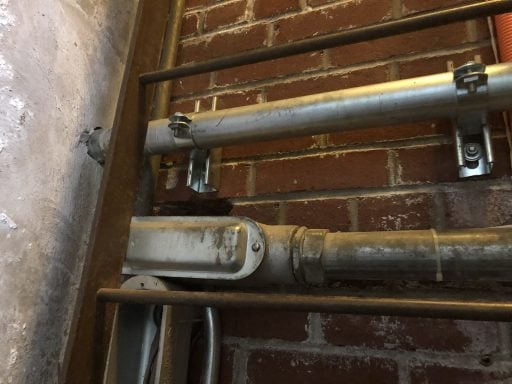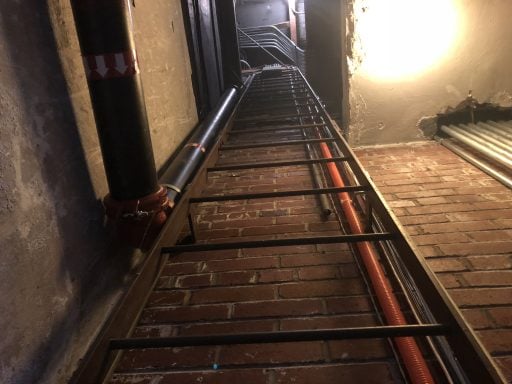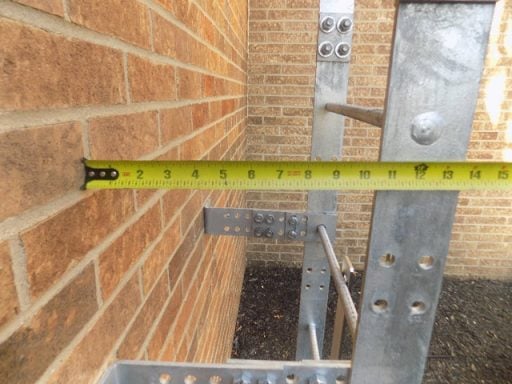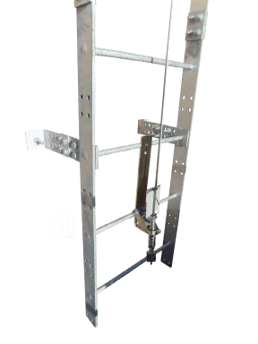
OSHA Compliant Roof Access Ladders: What You Need to Know
Knowing the details of every OSHA regulation can be tricky when you’re not a trained fall protection specialist — especially when the rules change. At Diversified Fall Protection, we’ve fielded many questions about access ladders and what fall protection they require.
For example, what if you have a 50-ft ladder, but it’s in 10-ft sections? Do you need fall protection then? Or what about a 24-foot ladder that begins 10 feet off the ground – what’s required? If you don’t know the right answer, you’ve come to the right place.
And since OSHA updated its regulations regarding fixed roof access ladders in 2017, it’s especially important to make sure you know whether your facility is safe and in compliance.
Total Fall Distance is Key
The short answer to the questions posed above is this: It depends on the distance a worker on the ladder could fall, not the length of any single section of the ladder. OSHA regulations require measurement of total fall distance above a lower level. Regardless of whether the ladder is a continuous single straight climb or includes side-step-off platforms, you need to measure from the top of the ladder to the lowest level.
TIP: Your fall protection should be calculated measuring from the top of the ladder to the lowest level.
If the fixed ladder will reach more than 24 feet above a lower level, you as the employer are required to incorporate a personal fall arrest or ladder safety system into the installation of the ladder. (This requirement is cited in OSHA Section 1910.28(b)(9)(i).)
In another installation scenario, a multiple section or side-step ladder may be made of several sections, each measuring less than 24 feet. If the total distance extends more than 24 feet above the ground, you must equip the entire ladder with personal fall arrest or ladder safety systems. Although the length of each section of the ladder may be less than 24 feet, a worker on that ladder could fall more than 24 feet in total.
OSHA Regulations for Roof Access Ladders
OSHA’s Slips, Trips, and Falls Regulations cover a broad range of fall protection topics, including fixed ladders. Note that these regulations were updated in 2017, which means your facility should either already be in compliance or planning changes if your ladder updates have not been completed yet.
OSHA Ladder Rule Changes
For fixed ladders, the most important OSHA rule changes involve minimum width and offset distance requirements.
Width: 16 inches
Offset distance: 7 inches
Additionally, it’s important to note that cage systems are no longer an acceptable protection device for ladders 24 feet and higher installed after Nov. 19, 2018. (Those installed prior to that date are exempt until 2036.)
OSHA also requires that if you make any adjustments, retrofits or extensions to a fixed access ladder currently considered compliant, you must ensure that a personal fall arrest or ladder safety system provides protection for the entire vertical distance of the ladder, including all ladder sections.
OSHA’s Ladder Compliance Enforcement Timeline
OSHA’s timeline for enforcement of OSHA regulations for ladders that extend more than 24 feet about the lower level, as well as the timetable for phasing out cages and wells as a means of fall protection, includes the following:
- For caged, fixed ladders installed before Nov. 19, 2018, employers have up to 20 years to install ladder safety or personal fall arrest systems
- For new fixed ladders installed on or after Nov. 19,2018, the employer must equip the ladder with a ladder safety or personal fall arrest system
- For ladder repairs and replacements, when an employer replaces any portion of a fixed ladder, the replacement must be equipped with a ladder safety or personal fall arrest system
- After Nov. 18, 2036, all fixed ladders must be equipped with a ladder safety or personal fall arrest system. Note that you won’t need to remove your cage after the final deadline. Rather, caged ladders will not be deemed OSHA-compliant without an additional means of fall protection.
Example: Bringing an Access Ladder Into OSHA Compliance
Walking working surfaces such as ladders are dangerous when the presence of pipe, conduit and other obstructions means there isn’t enough room for secure footing on a rung.
The 7-inch minimum standoff rule [OSHA 1910.23(d)(2)] states that the minimum perpendicular distance from the centerline of the steps, rungs or grab bars to the nearest permanent object in back of the ladder is 7 inches.
In one example, a DFP client had concerns about multiple obstructions running between the ladder and the wall. The pictures below illustrate such commonly found safety hazards associated with access ladders.

Conduit running between the wall and the ladder rungs makes for dangerous footing – and in this case, an OSHA violation. In the image above, note how a foothold or handhold on the ladder is completely obstructed by the conduit between the ladder and the wall behind it.
The next picture shows a slightly less dangerous section of the same ladder, with a bit more room on each rung. However, because objects are permanently attached to the wall behind the ladder, the 7″ minimum standoff distance is not met, and the ladder is not OSHA compliant.

In this case, our client would have two options to correct the situation: removing the existing stand-offs and increasing the distance between the wall and the rung to account for the obstructions, or starting from scratch with a new ladder.
The Compliant Access Ladder Solution: EZ Ladder
One of the features of our new EZ Series Fixed Access Ladders is Easy Up Technology, which includes adjustable, bolt-on stand-offs. This technology offers a fast and easy workaround for obstructions that block minimum standoff distance.

Achieving the minimum 7” perpendicular clearance is easy thanks to the design of the EZ Series fixed ladder.
Another advantage of our new fixed ladder design is the hole pattern running the entire length of each side rail section. In the event of a horizontal obstruction running between the wall and the ladder, simply select a different series of mounting holes and bolt the stand-offs in the desired location. Traditional ladders come with welded stand-offs, so a poorly placed run of conduit or pipe means removing the stand-off and field welding to work around the interference. EZ Series Fixed Ladders allow for quick and easy adjustments to ensure the minimum required stand-off distance is met.
Using Ladder Guards
Unguarded ladders can allow unauthorized personnel to access your rooftop, exposing your company to risk and liability. The traditional solution to this age-old problem is a hinged ladder door that secures the ladder with a lock.
Hinged ladder doors present a simple solution to unauthorized ladder access, but this style of ladder guard is not without shortcomings. For starters, ladder doors are typically fabricated from sheet metal, which adds weight that complicates installation and adds cost. Hinged ladder doors also present pinch points.
EZ Ladder Guard
The Diversified Fall Protection engineering staff set out to design an alternative to fabricated sheet metal ladder doors. The finished product, the EZ Ladder Guard, addresses all of the common pain points associated with traditional ladder guards.
EZ Ladder Guard Features

Available in 16” and 18” widths, the EZ Ladder Guard fits virtually any commercially available fixed-in-place access ladder. The engineering team did away with the hinged design and opted for a lightweight, corrosion-resistant 5052 aluminum panel that rests on the rung and locks in place.
To secure the ladder, use the lifting bar on the front surface of the panel, hook the mounting lip to a rung, and secure the guard to the ladder with a lock.
Our new design easily accommodates ladder lifeline systems, and the aluminum construction will withstand the elements and provide exceptionally long service life.
Expert Advice for Access Ladders
The proper ladder installation and ladder fall protection helps keep your team safe when it’s time to access the roof.
For assistance ensuring your facility’s roof access ladders are in compliance with OSHA’s regulations, contact one of our fall protection specialists.
Schedule an assessment with Diversified Fall Protection
Contact Us to request a fall safety review

b-1.jpg?width=1368&height=1340&name=Rail%20(175)b-1.jpg)

